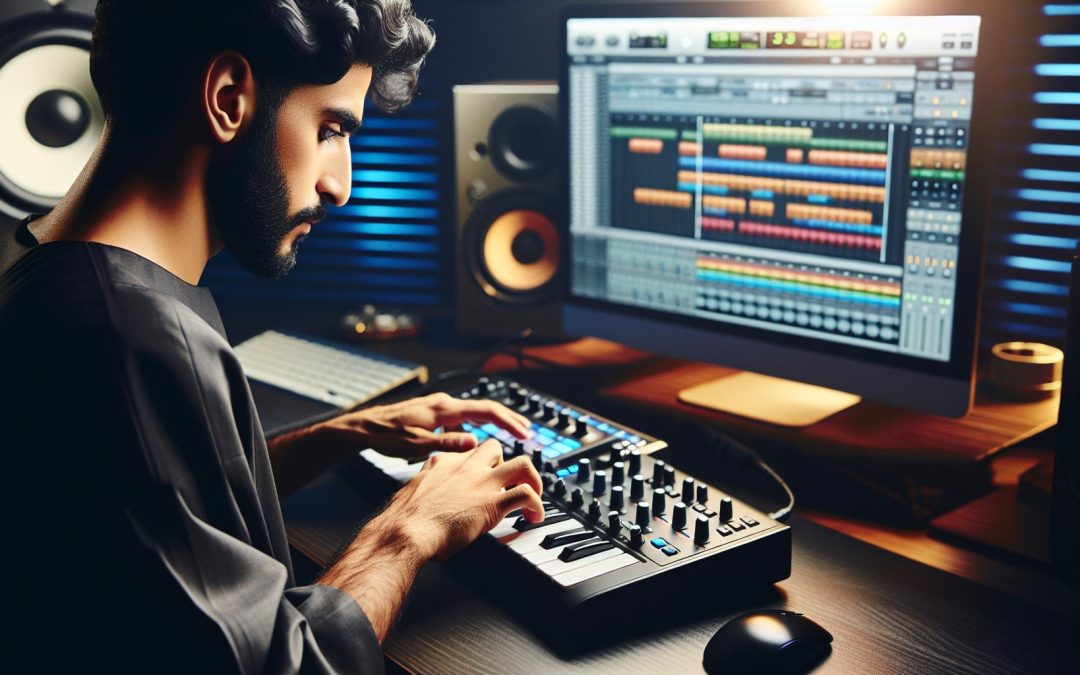In today's digital age, learning to play the keyboard has taken a modern twist with the advent of MIDI controllers. These versatile devices open up a world of musical possibilities, making it easier and more fun than ever to dive into the art of keyboard playing.
For beginners and seasoned musicians alike, a MIDI controller serves as a bridge between traditional music theory and cutting-edge digital sound production. It's not just about hitting the right notes anymore; it's about exploring an entire universe of sounds and textures at your fingertips.
Embarking on this journey can seem daunting at first, but fear not. With the right approach and a bit of guidance, mastering the keyboard through a MIDI controller can be an incredibly rewarding experience. Let's explore how to turn those initial tentative keystrokes into confident, expressive music making.
Understanding MIDI Controllers
When diving into the world of keyboard playing, one term that frequently pops up is MIDI controller. But what exactly is a MIDI controller, and how does it revolutionize the way we learn and play music?
A MIDI controller, in its essence, is a device that sends MIDI (Musical Instrument Digital Interface) signals to a computer or synthesizer. These signals are then translated into sounds by your software or hardware. Unlike traditional keyboards that produce sound internally, MIDI controllers rely on external sources for sound production. This characteristic opens up a vast expanse of musical possibilities, allowing users to access a wide array of sounds and textures beyond what is typically available in a single instrument.
Key Features of MIDI Controllers
MIDI controllers come in various shapes and sizes, each designed with specific functionalities to suit different musical needs. Here are some key features to look out for:
- Keys: They range from 25 to 88 keys, accommodating both limited-space setups and full-range performances.
- Pads: Many controllers include pads that can trigger loops, samples, or full beats, adding a percussive element to your playing.
- Knobs and Sliders: These controls manipulate sounds in real-time, allowing for dynamic expression and on-the-fly adjustments to parameters like volume, pitch, and effects.
- Connectivity: Most MIDI controllers offer USB connectivity for easy integration with computers and mobile devices. Some also feature traditional MIDI out ports for connecting to older equipment.
Learning Curve
For beginners, starting with a MIDI controller might seem daunting. The multitude of sounds and settings can overwhelm someone new to digital music production. However, it’s precisely this diversity that makes MIDI controllers so appealing. With the right approach and enough practice, users can go from simple melodies to complex arrangements, leveraging the controller’s features to enhance their musical expression.
- Size and Portability: If you're short on space or frequently on the move, a compact controller might be the best choice.
- Number of Keys: Think about the range you need. Are you looking for something more piano-like, or is a smaller range sufficient for your music?
- Additional Features: Do you need drum pads, sliders, or additional knobs? These features can significantly expand your creative possibilities.
- Budget: Prices vary widely, so
Choosing the Right MIDI Controller

When embarking on the journey of learning keyboard with a MIDI controller, choosing the right device is crucial for both beginners and seasoned musicians. It's not just about picking any MIDI controller but finding one that best suits an individual's musical preferences, playing style, and learning goals.
Firstly, the size and number of keys are paramount. MIDI controllers come in various sizes, from compact 25-key models to full-sized 88-key keyboards, mirroring a traditional piano. Beginners might prefer a smaller, more manageable size for ease of use and storage, while experienced players might seek the full range to express complex compositions fully.
- 25-Key Controllers: Portable and great for simple melodies
- 49 to 61-Key Controllers: Balance between portability and range
- 88-Key Controllers: Full piano range for complex compositions
Additional features should also be considered. Many MIDI controllers offer a variety of pads, knobs, sliders, and even touch strips, offering creative ways to manipulate sound and effects live. These features can significantly enhance a musician's ability to perform and record music dynamically. For instance, drum pads can add rhythm sections to compositions without a separate drum machine.
Connectivity is another vital aspect. Most MIDI controllers connect to devices via USB, but some offer MIDI out, Bluetooth connectivity, or even CV/Gate connections for older synthesizers. Ensure the chosen controller is compatible with the intended setup.
| Feature | Importance | Ideal For |
|---|---|---|
| Size and Number of Keys | Personal preference & space | Determining the range of play |
| Additional Features | Creative expression | Enhancing performance & recording |
| Connectivity | Setup compatibility | Ensuring seamless integration |
Budget plays a significant role as well. MIDI controllers range in price from very affordable options suited for those just starting to explore, to high-end models with advanced features tailored to professional needs. It's essential to strike a balance between cost and desired features to find value in an investment that grows with the musician's skills.
Before making a decision, they should consider trying out different models in-store if possible or watching detailed reviews and tutorial videos online. This hands-on or visual experience can provide insights into how the controller feels and responds, which specs and features resonate with their needs, and whether it aligns with their budget constraints.
Getting Started with Basic Keyboard Techniques

Once you've chosen the right MIDI controller that aligns with your musical preferences, playing style, and learning goals, it's time to dive into the fundamentals of playing. Basic keyboard techniques form the foundation upon which all your future skills will build, so it's essential to approach this stage with patience and consistency.
Understanding Posture and Hand Position
Believe it or not, how you sit and position your hands can make a huge difference in your playing. Here are a few tips they'll want to keep in mind:
- Sit upright with your back straight but relaxed.
- Keep your elbows slightly bent, allowing your arms to hang comfortably from your shoulders.
- Position your fingers curved over the keys, with your wrists level with the keyboard.
Mastering these basics ensures you're setting yourself up for success, reducing the risk of strain, and making it easier to reach the keys with precision.
Learning to Read Music
While it's possible to play by ear, understanding how to read music opens up a world of possibilities. Start with the basics:
- Familiarize yourself with the musical staff, notes, and their values.
- Learn about the clefs, with the treble clef being most commonly used for keyboard music.
- Practice identifying notes on the staff and locating them on your keyboard.
Resources are abundant, from online tutorials to keyboard-specific learning apps, so they'll find something that suits their learning style.
Developing Finger Strength and Dexterity
The keys of a MIDI controller might feel different from those of an acoustic piano, but the importance of finger strength and dexterity remains the same. Here are some exercises they can try:
- Practice scales and arpeggios to get comfortable moving up and down the keyboard.
- Use finger drills, alternating between slow, deliberate movements and faster runs to build agility.
- Incorporate hand independence exercises to improve the ability to play different rhythms or melodies with each hand.
Incorporating Dynamics and Expression
Music isn't just about hitting the right notes; it's also about how they play them. Dynamics (the volume of the music) and expression (the emotion and articulation) are key:
- Experiment with soft (piano) and loud (forte) passages to understand the range of expression.
- Use the MIDI controller's sensitivity settings to explore nuances in touch and sound.
- Listen to recordings of professional musicians and attempt to mimic their expressive techniques.
Exploring Advanced Features

As they progress in their journey of learning the keyboard with a MIDI controller, learners will find that diving into the advanced features unlocks a new realm of musical possibilities. These features not only enhance the sound but also contribute to a more engaging playing experience. Understanding how to use these tools effectively can transform a simple melody into a rich, complex soundscape.
MIDI Mapping is a powerhouse feature that most advanced MIDI controllers offer. It allows players to assign different sounds or effects to specific keys or pads on the controller. This customization is particularly useful for those looking to create unique compositions or replicate the complexity of a full band. By mapping drums, bass, and other instruments to their controller, musicians can essentially become a one-person band.
Another feature worth exploring is the Use of DAWs (Digital Audio Workstations). These software platforms open up endless possibilities for recording, editing, and mixing music. By connecting their MIDI controller to a DAW, learners can record their keyboard performances and apply a multitude of effects, adjust tempos, and layer tracks to produce professional-quality music. The most popular DAWs in the market include Ableton Live, Logic Pro, and FL Studio, each with its own set of unique features and workflow.
Incorporating Synthesizers and Virtual Instruments
The beauty of MIDI technology lies in its ability to control synthesizers and virtual instruments, empowering users to access a vast library of sounds beyond traditional keyboard tones. Synthesizers can simulate instruments like violins, trumpets, and drums, providing an entire orchestra at the artist's fingertips. Meanwhile, virtual instruments, software-based, offer even more variety and realism in sound production.
Learners should explore synthesizers that provide Analog Emulation for those vintage sounds from the '70s and '80s, as well as modern digital synths for cutting-edge sounds. Experimenting with these sounds can inspire new creative directions and bring additional layers of emotion to music.
MIDI Controller Software Integration
Most MIDI controllers come with proprietary software or are compatible with third-party applications that drastically expand their functionality. This software can include sound libraries, beat-making tools, and even lessons and games to help improve keyboard skills. Integration with such software not only makes practicing more fun but also offers valuable resources for music production and sound design.
Creativity with MIDI Controller

When it comes to unleashing one's creative potential, the MIDI controller emerges as a groundbreaking tool in the musician's arsenal. Not confined to mere keyboard input, these versatile devices facilitate a level of expressiveness and control previously unimaginable. They transform the traditional approach to music creation, making it more accessible and significantly more inventive.
Musicians and producers have the opportunity to customize their sound in unprecedented ways. Each key or pad on a MIDI controller can be mapped to trigger different sounds or effects, allowing for a dynamic and personalized performance. Imagine a scenario where pressing a single key unfolds layers of harmonies or intricate rhythms. This is not the stuff of dreams but a tangible reality with MIDI controllers. The possibility to assign multiple instruments to different sections of the keyboard invites an orchestral experience under the fingertips of the player.
Moreover, the integration of Digital Audio Workstations (DAWs) elevates the creative process to new heights. These sophisticated software platforms, such as Ableton Live and Logic Pro, offer a sandbox environment where every musical idea can be explored, refined, and recorded. Through DAWs, MIDI controllers become the bridge between the musician's imagination and the digital soundscape. They enable artists to record multiple layers, edit with precision, and experiment with arrangements, all in real-time.
The availability of vast libraries of virtual instruments and sounds further enhances the creative journey. Whether one's passion lies in classical piano, ethereal synth pads, or hard-hitting electronic beats, MIDI controllers, coupled with the right software, can bring any vision to life. The capability to switch between instruments, often mid-performance, ensures that creativity is never bounded by the limitations of physical space or budget.
Embracing the Learning Curve
Embarking on the journey of mastering a MIDI controller is as much about embracing the learning curve as it is about creativity. For beginners, the myriad of buttons, knobs, and sliders can seem daunting. However, this complexity conceals a world of possibilities, waiting to be uncovered. Many MIDI controllers come with built-in tutorials or compatibility with music education apps, easing the initial learning phase. As one becomes familiar with the hardware and software, these tools become extensions of the musician's intent and imagination.
Conclusion
Embracing MIDI controllers for learning the keyboard opens up a world of creativity and flexibility that traditional methods might not offer. With the ability to customize every aspect of the playing experience, from the sounds each key makes to the integration with powerful DAWs, learners have everything they need at their fingertips to explore and expand their musical horizons. While there's a learning curve, the journey is made easier with the help of tutorials and apps designed to make mastering these innovative devices both enjoyable and rewarding. So whether you're a beginner or looking to inject some new life into your keyboard practices, diving into the world of MIDI controllers could be the key to unlocking your full musical potential.
Harlan Kilstein began playing piano during covid with no piano background at all. He taught himself how to play learning what to do and what not to do.
Today he's an advanced intermediate player and can help you grow in your skills because he learned all this on his own.








